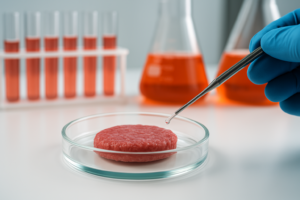
Imagine biting into a juicy burger that didn’t come from a cow. No farms. No slaughter. Just science. That’s the promise of lab-grown or cultivated meat — a groundbreaking innovation that could change the future of food.
In 2023 and 2024, several countries, including the U.S., Singapore, and Israel, approved the sale of lab-grown meat to the public. While it might sound like something out of a sci-fi movie, the science is very real — and advancing fast.
🧬 How Is Lab-Grown Meat Made?
Lab-grown meat is not fake or plant-based. It’s real animal meat, grown from a small sample of animal cells. Scientists extract stem cells from a cow, chicken, or other animal and place them into a nutrient-rich solution. Inside high-tech bioreactors, the cells multiply and form muscle tissue like in an animal’s body.
Over time, this tissue grows into the same type of meat you’d find on your dinner plate. Some companies even use edible scaffolds to shape the beef into familiar forms like nuggets or steaks.
The entire process takes a few weeks compared to the months or years it takes to raise livestock. Best of all, no animals are harmed in the process.
🌎 Why Does This Matter?
The traditional meat industry has a massive environmental footprint. It’s responsible for about 14–18% of global greenhouse gas emissions, uses vast land and water, and raises serious ethical concerns about animal welfare.
Cultivated meat could offer a solution. It uses up to 90% less land and water, produces fewer emissions, and eliminates the need for animal slaughter. Plus, it opens the door for cleaner, more controlled meat production — potentially reducing the risk of diseases linked to factory farming.
⚖️ What Are the Challenges?
Despite its promise, lab-grown meat still faces hurdles. Right now, it’s expensive — though prices are dropping quickly. Texture and taste have improved dramatically, but creating complex cuts like marbled steak is still tricky.
There’s also the question of public perception. Some people are hesitant about eating “meat from a lab,” even if it’s biologically identical to traditional meat. Regulatory frameworks are also still evolving, especially in countries with strict food safety laws.
🔮 What’s Next?
As technology advances, many experts believe lab-grown meat could become a mainstream option within the next decade. As production scales up, it may first appear in high-end restaurants and then move into supermarkets.
Major food companies and investors are already backing cultivated meat startups, betting on a future where science and sustainability go hand-in-hand at the dinner table.
One thing is clear: lab-grown meat isn’t just a trend — it’s a scientific leap that can reshape our food system, protect the planet, and redefine what it means to eat meat.